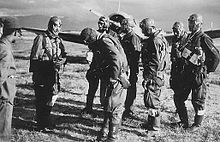Air forces of the Manchurian Empire
The Manchukuo Air Force ( Chinese 大滿洲帝國空軍 / 大満州帝国空军 , Pinyin Da Mǎnzhōu Diguo Kongjun , dt. Air forces of large Manchurian Empire ) were the air forces of the Japanese puppet state of Manchukuo in northeast China's Manchuria .
history
The Manchurian Air Force was founded in February 1937, when 30 selected soldiers from the Manchurian Army were sent to the Air Force Arsenal of the Japanese Kwantung Army in Harbin for training. The Manchurian Air Transport Company , founded in 1932 and later renamed Manchurian Aviation Corporation , is seen as its forerunner . This main task of the officially civil society was to take over transport and reconnaissance flights for the Japanese military stationed in Manchuria .
The first squadron was on the airfield of Xinjing under the command of a Japanese lieutenant set up and consisted initially of an old French biplane type Nieuport-Delage Nid 29 . Later, light bombers of the type Kawasaki KDA-2 and fighters of the type Nakajima 91 were delivered from Japan.
A second squadron was set up in Shenyang and a third squadron was formed in Harbin at the turn of 1938/39. From July 1940 these were coordinated from a central air defense headquarters in Xinjing.
Despite the name, only Japanese pilots flew in the air force in the first few years, and the maintenance units were largely made up of Japanese. Only after 1940 were ethnic Manchus permitted as pilots. For this purpose, a flight school was set up in Tongliao on August 30, 1940 , at which civil and military pilots were trained for the Manchurian Aviation Corporation. The school was about to close in January 1941 when a group of around 100 pilot students murdered their teachers and defected to an anti-Japanese guerrilla group in Manchuria. In September and October 1942, the flight school received twenty training aircraft of the types Tachikawa Ki-9 , Tachikawa Ki-55 and Mansyū Ki-79 for the first time . This happened in view of the sharp rise in the loss rate of Japanese pilots in the Pacific War .
Around the same time, the air force transport aircraft of the types Nakajima Ki-34 , Junkers Ju 86 , Tachikawa Ki-54 and Manshū Hayabusa , which served as transport units for the Manchurian government and the imperial family.
In 1944, the Manchurian Air Force was withdrawn from the command of Emperor Puyi and placed under the Japanese 2nd Air Army in order to better coordinate their operations. At that time, the Air Force had a fleet of around 100-120 combat aircraft, mainly of the Nakajima Ki-27 type . The money for the purchase of these aircraft was mainly raised through "donations" from various Japanese companies based in Manchukuo. Since the main task was to repel enemy air strikes, it had only a few tactical bombers of the Kawasaki Ki-32 type .
When the American air strikes on Manchuria increased in intensity in the course of 1944 and the supply situation in Manchuria came to a head, the Manchurian air forces were also ordered to use kamikaze tactics . The first successful ramming attack against Boeing B-29 bombers was reported in December 1944. From the beginning of 1945, new fighters of the types Nakajima Ki-43 and Nakajima Ki-44 were requested from Japan . Since the American air raids on Manchuria decreased during this time, but were intensified in parallel on the main Japanese islands, the Japanese delivered very few of these aircraft.
When an attack by the Soviet Union on Manchuria became more likely in the course of 1945, the Manchurian fighter pilots were retrained to attack land vehicles. After the beginning of the Soviet invasion , the 2nd Japanese Air Army ordered the Manchurian Air Force to self-sacrifice and attack Soviet tanks in order to destroy them. Due to the rapid collapse of the Japanese and Manchurian forces, this order has apparently not been carried out.
literature
- William Green: Flying Colors. Motorbooks International, Osceola WI 1997, ISBN 0-7603-1129-3 .
- Philip S. Jowett: Rays of the Rising Sun. Armed Forces of Japan's Asian allies, 1931-1945. Volume 1: China and Manchukuo . Helion and Company Ltd., Solihull 2005, ISBN 1-874622-21-3 .
Web links
- Private page about the manpower and organization of the Manchurian Army and Air Force ( Memento from August 7, 2014 in the Internet Archive ) (English; March 24, 2002)

